The debate over the marble sculptures removed from the Parthenon by Thomas Bruce, Seventh Earl of Elgin and acquired by the British Museum 200 years ago is the longest running cultural property controversy in the world. Because it is the most famous of all cultural-property debates, it has also the highest symbolic value for those who argue for repatriation or retention of other artistic treasures in museums around the world. Yet the story – and backstory – of the Marbles are no guide to resolving cultural property conflicts today. For one thing, what Elgin did, though legal and even acceptable 200 years ago and sanctioned in the end by Greece’s Ottoman rulers, would violate a half dozen international conventions and every museum standard of today. For another, facts matter, and the history of the taking of the Marbles is unique.

Thomas Bruce, 7th Earl of Elgin (1766-1841), by George Perfect Harding 1780–1853, after Anton Graff (1736–1813), Date 1787, National Portrait Gallery, public domain, Wikimedia Commons.
Elgin’s story carries with it all the distaste for Empire that many British citizens have felt since the postwar era. The 7th Earl did not burn palaces and take trophies in the name of Empire (though another Elgin is known for doing exactly that in China). He was a diplomat driven by conjoined passions to promote the art of ancient Greece and to humiliate Napoleon, who was not only Britain’s geopolitical rival but also attempting to secure the Marbles for France.
The history of the taking of the Marbles has not always been well understood. This article attempts to set forth the facts and the conflicting arguments.[1] We hope it enables our readers to better frame both the debate over the Marbles and the potential consequences of any resolution.
As complex and as rancorous as the debate over the Marbles has sometimes been, what matters most is that they continue to exist and to inspire us all. They have been a remarkably beautiful and thought-provoking presence in the world far longer than any current state, political concept or national identity. Whatever temporal ‘solution’ is found for the Marbles, whatever place they rest in for the next 200 years, they must remain as accessible as possible to the global community. Like all great art, they carry messages for humanity that transcend present national or political interests. That is where their greatest value lies.
Recent events.
Greece’s campaign for the return of the Marbles has become more intense since it abandoned the legal campaign headed by celebrity lawyer Amal Clooney in 2015 and announced it would work instead through diplomacy and moral persuasion. Some recent events in the Marbles dispute:
- October 2021 – UNESCO ‘s Return and Restitution intergovernmental committee (ICPRCP) issues a recommendation urging the UK and Greece to find a government-to-government solution for the return of the Marbles.
- November 15 2021- Greek Prime Minister Kyriakos Mitsotakis meets with UK Prime Minister Boris Johnson and offers the possibility of a loan exchange of the Marbles for other objects in Greek museums if they are returned. Johnson reiterates his government’s position that the matter is purely for the Trustees of the British Museum to decide.
- December 19 2021 – British newspaper The Guardian reveals that as a student at Oxford, Boris Johnson met with Greek activist Melina Mercouri at the Oxford Union and wrote an article demanding that the Marbles be taken from “this northern whisky-drinking guilt-culture, and be displayed where they belong: in a country of bright sunshine and the landscape of Achilles.”[2]
- January 2022 – Italy’s Antonino Salinas Regional Archaeological Museum in Palermo, Sicily breaks tradition to lend the Athens Acropolis Museum a shoebox size fragment from a Parthenon frieze depicting a foot peeking out from beneath a tunic fringe in exchange for a loan of a statue of the goddess Athena and an archaic amphora. Italy suggests that the loan may effectively become permanent.
- February 2022 – UK’s Minister for Arts, Lord Stephen Parkinson reiterates that “this is a matter for the trustees of the British Museum, who legally own the sculptures… decisions relating to the care and management of its collections are a matter for its trustees.”
- March 29 2022 – The Oxford-based Institute for Digital Archaeology threatenes to sue the British Museum to gain access to scan the entire Parthenon sculptures, using ladders, after permission was refused. The organization then sends in a group without permission to scan a number of works in the galleries, stating that museum rules automatically grant permission. It wishes the BM to return the originals and exhibit copies.
- May 17 2022 – UNESCO announces Stephen Parkinson’s offer to meet with Greek Culture Minister Lina Mendoni to discuss the status of the Marbles.
What is the real story behind the taking?
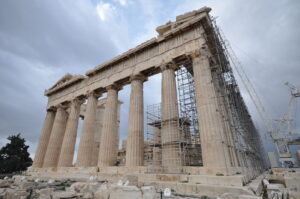
Parthenon – Acropolis, 2 December 2008, Author Jorge Láscar from Australia, CCA 2.0 Generic license.
In ancient times, the Acropolis was the citadel as well as the religious center of Athens. Its walls enclosed several major sanctuaries and small temples, with altars and statues scattered throughout the complex. Athenian statesman Pericles ordered its construction under the direction of the sculptor Phidias; it was completed in 438 BC. The building was elaborately ornamented: the upper platform was surrounded by forty-six Doric columns surmounted by two triangular pediments containing sculptures in the round depicting Athena’s birth and her battle with Poseidon. The architrave included ninety-two metopes with scenes from mythological and historical battles carved in high relief. A low-relief frieze around the inner chamber depicted the final event of the Panathenaea festival: a procession of priests, citizens, warriors, and women bringing sacrificial animals and an embroidered garment to adorn the statue of Athena.
At the time the Marbles were taken, Athens had been ruled by the Turks for 400 years and had long been a humble backwater of the Ottoman Empire. The Parthenon had remained in good preservation through its conversion into a church in the Middle Ages and then into a mosque. In 1687, however, the building was severely damaged by the explosion of a powder magazine stored in it during a battle between the Turks and the Venetians. The roof was destroyed and architectural and sculptural remains were left strewn on the ground.
By 1800, Athens was reduced to a squalid settlement of huts and bazaars crowded onto the north and east slopes of the Acropolis. The Turkish garrison had built houses and gardens on the plateau and laid out fortifications there. William St. Clair wrote that, “Everywhere it was obvious that for years the ruins had been a main source of building materials. Slabs of crisp-cut marble were built into rude modern walls, and here and there, pieces of sculpture could be seen among the fortifications.”[3]
Pentelic marble pieces from within the Acropolis were also crushed and reduced to lime for construction. Drawings by travelers made in the decades before Elgin’s men arrived show that fallen sculptural and architectural elements were rapidly disappearing and the frieze and metopes being chipped away by tourists.
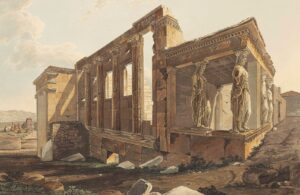
The Erechtheion on the Acropolis of Athens (c. 1805), note replacement of the Caryatid by the Turks with the depicted brick column. From Views in Greece, (Rodwell and Martin: London 1821) p. 39, Author Edward Dodwell (1767 -1832)
Elgin arrived in Constantinople in 1799, determined to use his diplomatic post there to secure Greek antiquities for the British Museum. Elgin hired an Italian artist, Giovanni Battista Lusieri, and a work crew, and sent them to Athens under the direction of his chaplain and secretary, the Reverend Philip Hunt.
Elgin’s original intent was to take extensive measurements and make drawings and plaster casts from the Parthenon and other ancient ruins. He planned to collect antiquities, but not to dismantle or remove sculptures from existing monuments. However, beginning when Elgin was residing in Constantinople, Hunt and Lusieri were allowed by local authorities to dismantle a substantial proportion of the finest of the remaining decorative elements on the Parthenon. Elgin could not resist. Over the course of eight years, his workmen removed 274 feet of the frieze of marble blocks that surrounded the Parthenon’s main inner chamber, fifteen of the ninety-two metopes from the outer colonnade, and seventeen figures in the round from the triangular pediments. They also compromised the building’s physical structure by removing the cornices above the frieze in order to sever the pins holding the marble slabs in place.
Elgin headed home to England from the Porte in 1802, traveling first to Athens to review the ongoing work at the Acropolis. He was a deeply disappointed man. His political and military successes as Ambassador had been jeopardized by reversals in British policy and he had suffered a terrible illness in which his nose was almost completely eaten away by infection, leaving a festering sore that refused to heal. His young wife was weary of the tedium of diplomatic life and dismayed, to say the least, at her husband’s disfigurement. Nonetheless, he saw the acquisition of the Marbles as not only a personal achievement, but a means to astonish and transform British arts – to give it new impetus by reframing an art history dominated by the duller forms of Roman classicism.

Thomas Phillips: Portrait of Lord Byron (1788–1824), 1813, Newstead Abbey, exhibited at the Royal Academy summer exhibition, Somerset House, 1814.
Elgin and his family left for France while Lusieri continued to work alone until 1808, excavating buried sculptures and other antiquities. When war between England and France broke out in 1803, Elgin and his family were trapped in France. Elgin had made an enemy of Napoleon by helping to drive the French from Egypt and Napoleon was said to have been especially bitter that Britain, not France, had secured the Marbles. While Elgin was alternately imprisoned and under house arrest, several shipments of sculptures were released by the Porte and sent to England, where they were installed by Elgin’s mother in a temporary “museum.” Elgin’s wife was permitted to return to England in 1805, escorted by a handsome friend, Robert Ferguson, with whom she soon began a very indiscreet affair. When Elgin was finally able to leave France in 1806, he was deeply in debt, physically and psychologically damaged, and fixated upon the Marbles as the one great success of his life.
The Marbles stunned the British art community. Roman art, not Greek, had been considered the artistic ideal and the beauty and naturalism of the Marbles were a revelation to many artists. Benjamin West wrote that their variety was “so magnificent and boundless, that every branch of science connected with the fine arts cannot fail to acquire something from this collection.”[4] J.M.W. Turner wrote to thank Elgin for “rescuing the sculptures from barbarism.”[5] Previously, it had been commonplace to restore ancient sculpture by re-carving broken areas. When Canova was approached by Elgin to do this, he refused, and is reported to have said that it would be “sacrilege in him or any man to presume to touch them with a chisel.”[6] Antiquities began to be viewed as timeless works of art rather than merely decorative objects.
Elgin expected to be honored for securing the Marbles at the expense of the French. Instead, his legal claim was questioned almost immediately and he was attacked by some of the most eminent cultural figures of his day. [7] There was fierce debate in Parliament over the purchase of the Marbles for the British Museum. Some argued for keeping them for their protection, others for holding them in trust; a minority wished to return them to the Ottoman government.

Theodore Vryzakis, The Reception of Lord Byron at Missolonghi, 1861, National Gallery of Athens, public domain, Wikimedia Commons.
The most eloquent and effective arguments against the removal of the Marbles were made in verse by Lord Byron. Byron had been friends with Lusieri at Athens and even fell briefly in love with Lusieri’s wife’s young brother. Byron warned Elgin in 1812 that he would attack him in his new work, Childe Harold’s Pilgrimage.[8] Elgin thought that the public attention would further his cause with the government, but he vastly underestimated the poem’s virulence. In the end, the Marbles were Elgin’s social, financial, and political ruin. Parliament finally authorized the purchase of his collection and its placement in the British Museum in 1816, but Elgin recouped less than half of his expenses and died impoverished in France, where his name has become an epithet synonymous with the looting of art treasures, elginisme.
Greece’s claims for the Marbles.
This is our history, this is our soul… You must understand us. You must love us. We have fought with you in the second war. Give them back and we will be proud of you. Give them back and they will be in good hands.
Melina Mercouri, 1983[9]
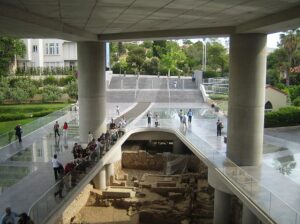
New Acropolis Museum, Athens. Ruins in the entrance, 2011, Author Tomisti, CCA-SA 3.0 Unported license.
Greece made its first formal request for the return of the Marbles over 170 years later, in 1983. Melina Mercouri, then serving as Greek Minister of Culture, delivered a dramatic call for their repatriation and grassroots organizations were formed to lobby for the Marbles’ return in both Britain and Greece.[10] The British government has continuously avoided the issue, insisting that legal responsibility lay with the British Museum’s Trustees.
With the completion in 2009 of a new museum[11] to house artifacts from the Acropolis along with the remaining sculptural elements from the Parthenon in Athens, the fate of the Marbles again became as public and controversial an issue as it had been in Lord Elgin’s time.
The British Museum’s webpage for the Marbles[12] discusses the claims surrounding the Marbles at length. The Trustees have continued to state that their duty was to preserve and maintain all the collections in their care and to make them accessible to world audiences. The museum notes that it lends thousands of objects every year; while it is equally willing to consider loans to Athens, all loans have ‘the simple precondition that the borrowing institutions acknowledges the British Museum’s ownership of the object,” which Greece refuses to do. The museum did lend a major pediment sculpture of the river-god Ilissos to the State Hermitage Museum in St Petersburg in 2014. Loans, even extended loans, are unlikely while Greece claims ownership; Greek Cultural Minister Lina Mendoni insisted in September 2021 that “Greece has a valid and legal claim to demand the return of the sculptures to their place of birth.”
Was it legal?
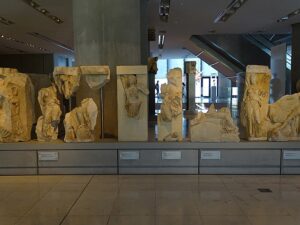
Sculptures in the Acropolis Museum, Athens, 12 July 2019, Author Ad Meskens, CCA-SA 4.0 International license.
Essentially, the legality of the removal is based on whether or not Elgin’s actions were authorized by the Ottoman government. It is generally accepted that, rightly or wrongly, the granting of permission for the dismemberment of the Parthenon was within the rights of the Ottoman sovereign at the time, and that although Elgin exceeded his authority in physically removing sculptures from the structure, their export was eventually permitted by Ottoman authorities.
One issue, raised by Professor David Rudenstine[13] decades ago, is the validity of a firman granting Elgin limited rights to remove objects issued by the Porte. During its first year, the Elgin expedition’s work of drawing and making casts had been continually hindered by the local Ottoman officials in Athens; Lusieri’s scaffolding was taken down and he and his men were often refused permission to work on the site. At Hunt’s request, Elgin obtained a firman, a document from the Ottoman government at Constantinople giving official authorization to allow Elgin’s workers free access and to permit digging to expose the foundations of the buildings for study. In Athens, Hunt was able to utilize this document to obtain permission from the local authorities, the Disdar and Voivode, to remove many large sculptural elements from the Parthenon itself.
Hunt had also requested that a translation of the document be sent to him. When the British Parliament considered the purchase of the Marbles, an English translation of this purported translation (from Turkish into Italian) of the original firman was entered into the records of the Parliamentary review committee and used to legitimate Elgin’s acquisitions.[14]
The crucial element of the document states, “[I] t is incumbent on us to provide that they meet no opposition in… [And here follows a long list of activities, from walking through to copying, drawing, molding, and measuring] and that no one meddle with their scaffolding or implements nor hinder them from taking away any pieces of stone with inscriptions and figures.”
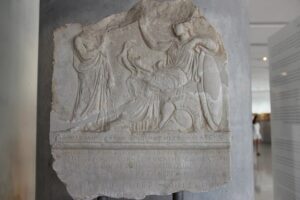
Acropolis Museum, Athens, Marble Relief, 19 July 2016, Author Gary Todd from Xinzheng, China, CC0 1.0 Universal Public Domain Dedication.
Professor Rudenstine has questioned both the authenticity of the translated document and the existence of the original. The Italian “translation” has several omissions within the document and lacks a seal. Rudenstine has been unable to locate any record of the original firman or of any related documents in the Ottoman archives. He suggests that the Parliamentary Committee had an interest in obtaining the Marbles and in clouding the legal issues, noting the difficulty of tracing this, as many of the original records of the 1816 Parliamentary review committee were lost in a fire.
However, as legal scholar John Henry Merryman points out, the validity of the document is not relevant. Elgin did not limit his activities to drawing, measuring, casting, digging, and taking up fallen pieces. The Rev. Hunt clearly exceeded the scope of any activity permitted in the document. Elgin’s legal position rests instead on the tacit acceptance of his actions by the local authorities during the eight years spent in physically removing the sculptures from the structure, and the fact that after a delay of some months during which permission was withheld, the Ottoman authorities in Constantinople authorized the shipping of the Marbles to Britain.
According to Merryman, the legal norms, both at that time and today, allow a government to legitimate an action after the fact, and that is what the Ottomans appear to have done. The accepted international law of the time allowed the Ottoman government to dispose of what was essentially State property. The higher authorities at the Porte seem to have been eager to offer favors to Elgin, whose position as Ambassador allowed him tremendous influence after the British defeat of the French in Egypt. The local Ottoman officials in Athens, the Voivode and Disdar, appear to have accepted bribes from Elgin and to have been afraid that they would be punished for allowing the work to continue, since Hunt requested that Elgin obtain additional letters of assurance to them from the Porte. Nonetheless, the Ottoman government was willing to overlook the local overstepping of authority and the statues were eventually permitted to travel.
Time is also a factor in the legal argument. The Greeks gained their independence from Ottoman rule in 1828, and the first official diplomatic demand for the return of the Marbles was made through Minister Mercouri in 1983. Greece has never sued in English court seeking the return of stolen property; if they did so now, the statute of limitations for such an action would definitely have run.[15]
The ethical arguments: repose versus return.
The legal argument is of less moment today because although they frequently describe the taking as illegal, the Greek government has declined to raise it in discussions with the British Museum.[16] The ethical argument now forms the core of the debate.
Is it morally correct for Britain to retain the Marbles? Here the arguments have been identified as falling into broadly cultural nationalist and internationalist categories.[17]
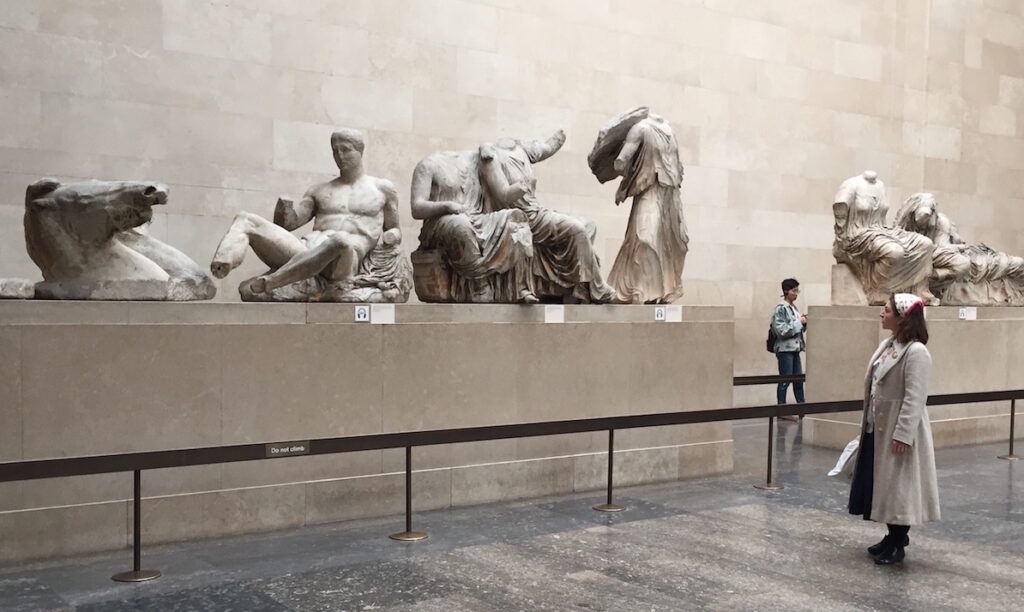
The Parthenon Marbles at the British Museum. 2017. All rights reserved.
The essence of the cultural nationalist argument is that the sculptures are Greek and therefore belong in Greece, either restored to the Parthenon, or in as close proximity to the Acropolis as possible. The Marbles are an inalienable symbol of Greek identity, representing Greek history at a time of great cultural achievement. Their absence is a personal and national loss to all Greek citizens. The fact that Greece still has enormous amounts of ancient art of exceptional quality may weaken the logical basis for this argument. John Henry Merryman has asked if it is theoretically necessary that all Greek art be returned in order to make Greek identity whole. He also poses the question whether Greek identity suffers or is enhanced by the honored place given Greek art in many world museums.[18]
For the Greeks, British ownership of the Marbles denies Greece’s legitimate interest in the preservation, study, and enjoyment of the Marbles. Greece has an interest in utilizing the Marbles to enhance the country’s prestige and a right to exploit them commercially, as the British Museum now does, to increase tourism. Without physical possession of the Marbles, Greece has lost a part of its national wealth.
Organizations in Britain add another element, saying that retention of the Marbles by Britain demonstrates adherence to an Imperialist ethos, a relic of an aggrandizing past that is no longer in keeping with their identity as Britons. Whether or not the Marbles were legally removed, returning them would be an act of enlightened self-interest.
However, the fate of the Marbles is equally tied to the place of Greek culture in the development of interconnected civilizations that extended from the Mediterranean far into Western Asia and to a common European cultural heritage consciously founded on a Hellenic past. The internationalist argument is grounded on issues of preservation, education, and optimum use of this common cultural heritage.
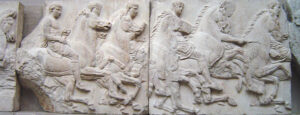
Parthenon marbles, Duveen Gallery, British Museum, Author: ChrisO, 26.06.2004, CCA-SA 3.0 Unported license
One of the strongest arguments raised in the nineteenth century to justify Elgin’s actions was that the wholesale removal of the Marbles was the only way of preserving the Parthenon’s sculptural elements, if not the building itself, intact. It is true that the Parthenon and other structures on the Acropolis were being damaged by the visiting tourists, local antiquities dealers, and agents of other countries. Conversely, Elgin’s workmen severely damaged the context for the sculptures, the Parthenon itself, even if removing the statues did preserve them.
Others say that the Marbles were sure to be removed by somebody, if not by the British, then by the French or the Bavarians. In the last years of the eighteenth century, the French ambassador to the Porte had established his own agent at Athens, Fauvel, with instructions to “…enlever tout ce que vous pourrez.”[19] Merryman points out that this is a morally ambiguous argument; one person is not justified in a wrongful act just because another person will do it if he does not.[20]
The argument that taking the Marbles preserved them has also been challenged by pointing to an incident that took place between 1937 and 1938 in which the art dealer Lord Duveen, who was financing a new gallery for the British Museum, concealed his intention from curators and bribed museum staff to do an abrasive cleaning of the Marbles in order to whiten them, thereby removing surface patina and traces of their original paint.[21]

Reinstallation of the Marbles after WW2. The sculptures were stored underground to protect them from German air raids during the blitz.
There are also questions regarding greater access to or better use of the Marbles. Is it more important for 1.5 million people a year to see them in Greece (the new Acropolis Museum in Athens has not drawn the international visitors it expected) or for 6 million visitors from around the world to see them in the British Museum each year?[22]
The argument for wholeness and the integrity of the Marbles is of less weight because they cannot ever be returned to the Parthenon itself. The sculptures now in the Acropolis Museum were removed by the Greek government to protect them from Athens’ Pentelic marble–consuming smog.[23] Are the risks attendant on moving the Parthenon Marbles, the risk of having all the Parthenon sculptures in a single location, and the reduction of access in terms of the number of people who will see them justified in order to put all the Marbles together in another museum?
There is also the legal and ethical principle of repose. It seems clear that moving the Marbles will not increase their protection, preservation, or access. Therefore, there is something to be said simply for leaving them where they are.
Finally, today’s arguments for repatriation are framed as a moral imperative to return objects to a ‘people’ whose identity is compromised and harmed by their loss. But objects are not returned to people – they are returned to national governments, which have their own agendas and are not scrupulous in using cultural heritage as political capital in their domestic and international interests.
For the sake of the Marbles and their message, one must consider whether national control truly outbalances the benefits of the humanist context of a world museum like the British Museum, in which the Marbles are seen as part of the history of the entire Western world and in the context of the larger artistic endeavor of all mankind.[24]

The Elgin Marbles in the British Museum, 10 September 2010, Author Txllxt TxllxT, CCA-SA 4.0 International license
[1] This article draws upon past writings by the author, particularly The Elgin Marbles, in Who Owns the Past, Kate Fitz Gibbon, Ed. Rutgers University Press, 1995. Sources for that article included biographies of Elgin by William St. Clair and Theodore Vrettos, the work of legal scholars John Henry Merryman and David Rudenstine, publications of the Hellenic Ministry of Culture, and statements by the British Committee for the Restitution of the Marbles.
[2] Helena Smith, Boris Johnson’s zeal to return Parthenon marbles revealed in 1986 article, 18 December 2021, https://www.theguardian.com/artanddesign/2021/dec/18/boris-johnsons-zeal-to-return-parthenon-marbles-revealed-in-1986-article
[3] William St. Clair, Lord Elgin and the Marbles: The Controversial History of the Parthenon Sculptures, Oxford University Press, 1983, republished 1998, 51.
[4] Theodore Vrettos, The Elgin Affair, Arcade Publishing, New York, 1997, 163.
[5] Ibid, 163
[6] St. Clair, Lord Elgin, 152, citing The Letters of Mary Nisbet, Countess of Elgin.
[7] Among his most formidable opponents was Richard Payne Knight, a leading member of the Society of Dilettanti.
[8] Despite their apparent friendship, Lusieri was also harshly criticized by Byron. Vrettos, The Elgin Affair, 157. Byron appears to have made romantic conquests in the Mediterranean with the same avidity (and patronizing smugness) with which Elgin collected antiquities. Ibid. 125–32,
[9] Merryman, John Henry, Thinking About the Elgin Marbles, Michigan Law Review, Vol. 83 at 1883, quoting an article from the San Francisco Chronicle, May 26, 1983, at 26, col. 1, reporting on a press conference by Minister Mercouri.
[10] Active organizations include the British Committee for the Restitution of the Parthenon Marbles, http://www.parthenonuk.com; the Friends of the British Committee, http://www.uk.digiserve.com/mentor/marbles/friends.htm; the US Committee on the Parthenon; The Canadian Committee for the Restitution of the Parthenon Marbles and the International Organising Committee Australia for the Restitution of the Parthenon Marbles. Greek government efforts to recover the Marbles are described on the website of the Hellenic Ministry of Culture, http://www.culture.gr. The Melina Mercouri Foundation may also be accessed through the Hellenic Ministry of Culture website.
[11] Acropolis Museum, Wikipedia, https://en.wikipedia.org/wiki/Acropolis_Museum.
[12] The Parthenon Sculptures, The Trustees’ statement, https://www.britishmuseum.org/about-us/british-museum-story/contested-objects-collection/parthenon-sculptures/parthenon
[13] Sources for this section include: David Rudenstine, A Tale of Three Documents: Lord Elgin and the Missing, Historic 1801 Ottoman Document, Cardozo Law Review, Vol. 22, July 2001, No. 5–6; David Rudenstine, Lord Elgin and the Ottoman: The Question of Permission, Cardozo Law Review, Vol. 23, January 2002, No 2; David Rudenstine, Did Elgin Cheat at Marbles?, The Nation, May 29, 2000.
[14] St. Clair, Lord Elgin, Oxford University Press, 1983. St. Clair located a document in Italian expressed in the same terms among Lord Elgin’s papers, and a facsimile was provided to Professor Merryman, who states that the English version accepted by Parliament appears to be an accurate translation of the Italian original.
[15] Merryman, Thinking, 1901.
[16] The official Greek position on the restitution of the Parthenon Marbles to Athens, Hellenic Ministry of Culture, http://odysseus.culture.gr/a/1/12/ea121.html
[17] Merryman, Thinking, 1911–20. Also see John Henry Merryman and Albert E. Elsen, Law, Ethics, and the Visual Arts, Kluwer Law International; 4th edition, 2002.
[18] Merryman, Thinking,1913.
[19] William St. Clair, Lord Elgin and the Marbles, Oxford University Press, 1983.
[20] Merryman, Thinking, 1905.
[21] St. Clair, William, The Damage to the Marbles, 1937–1938, Lord Elgin and the Marbles, Oxford University Press, 1983.
[22] Dr. James Beresford, Is the Acropolis Museum losing the numbers game? The Greek Reporter 6 November 2013, https://greekreporter.com/2013/11/06/is-acropolis-museum-losing-the-numbers-game/#:~:text=Writing%20in%20the%20Museums%20Journal,1.5%20million%20people%20each%20year. And Eleftheria Pantziou, Acropolis Museum Celebrates 10 years and 14.5 million visitors, 5 June 2019, https://news.gtp.gr/2019/06/05/acropolis-museum-celebrates-10-years-14-5-million-visitors/
[23] Martin Bailey, “New Acropolis Museum to feature recreated Parthenon frieze”, The Art Newspaper, https://www.theartnewspaper.com/2007/07/01/new-acropolis-museum-to-feature-recreated-parthenon-frieze
[24] John Henry Merryman, Whither the Elgin Marbles? in Imperialism, Art And Restitution, John Henry Merryman, ed., New York: Cambridge University Press, 2006.
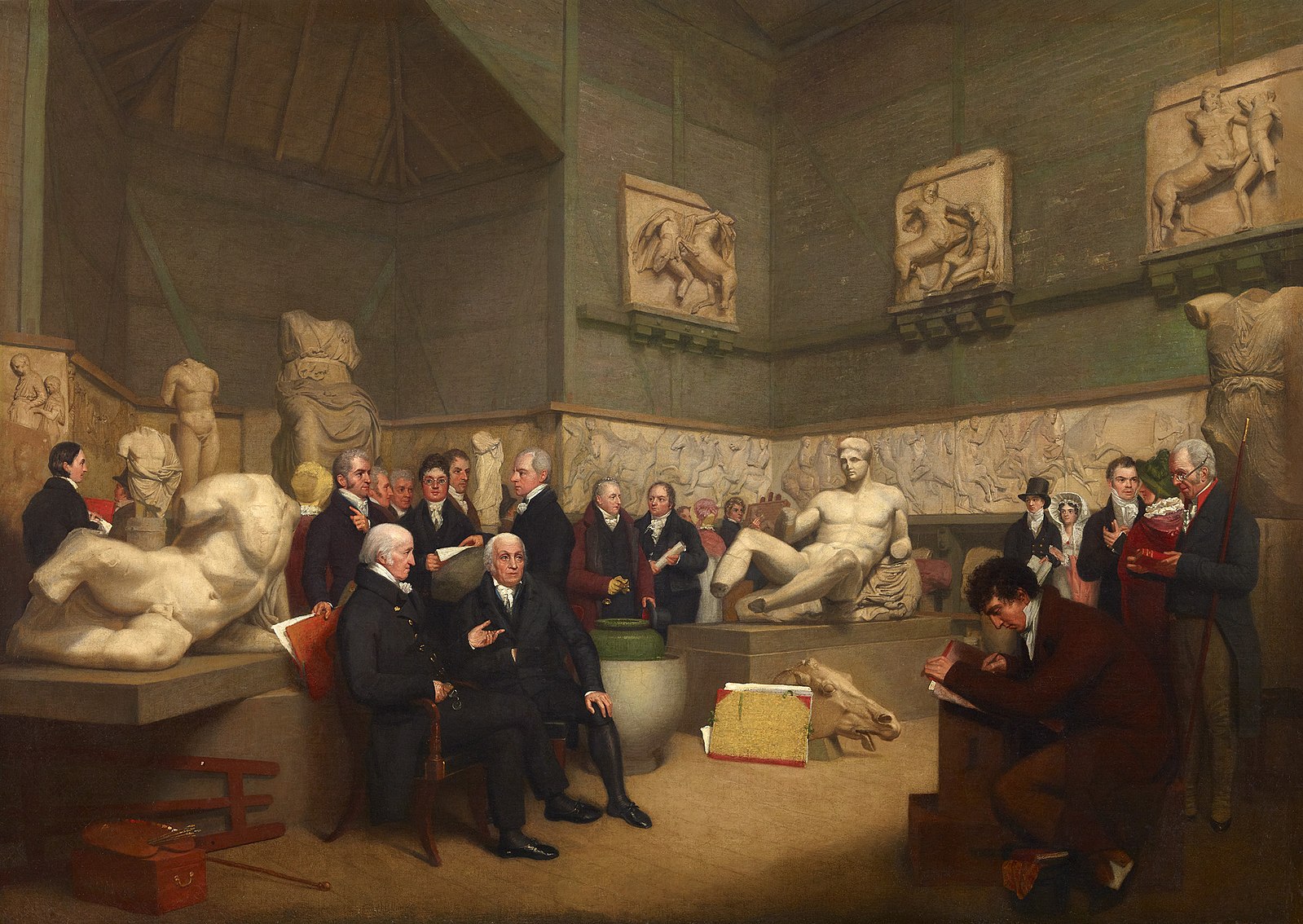 Archibald Archer (1791-1848), The Trustees of the British Museum, as well as the painter (right, sitting), are depicted pondering the artistic and humanistic value of the Parthenon sculptures (1819), on display in “The Temporary Elgin Room” of the museum as of 1817. Date 1819, The British Museum, research collection, Wikimedia Commons.
Archibald Archer (1791-1848), The Trustees of the British Museum, as well as the painter (right, sitting), are depicted pondering the artistic and humanistic value of the Parthenon sculptures (1819), on display in “The Temporary Elgin Room” of the museum as of 1817. Date 1819, The British Museum, research collection, Wikimedia Commons. 

